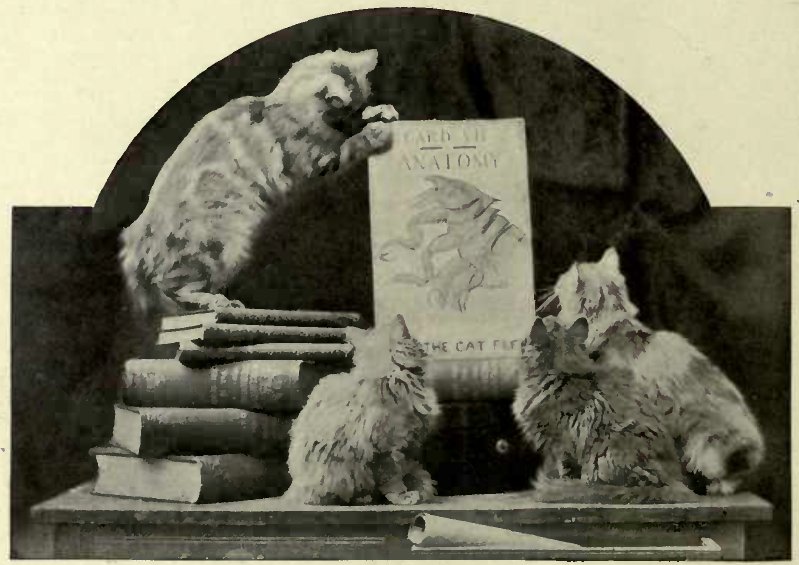XV. ORANGE PERSIANS
Texte und Bilder aus “THE BOOK OF THE CAT” von Frances Simpson aus dem Jahre 1903
THE BOOK OF THE CAT
CHAPTER XV.
ORANGE PERSIANS
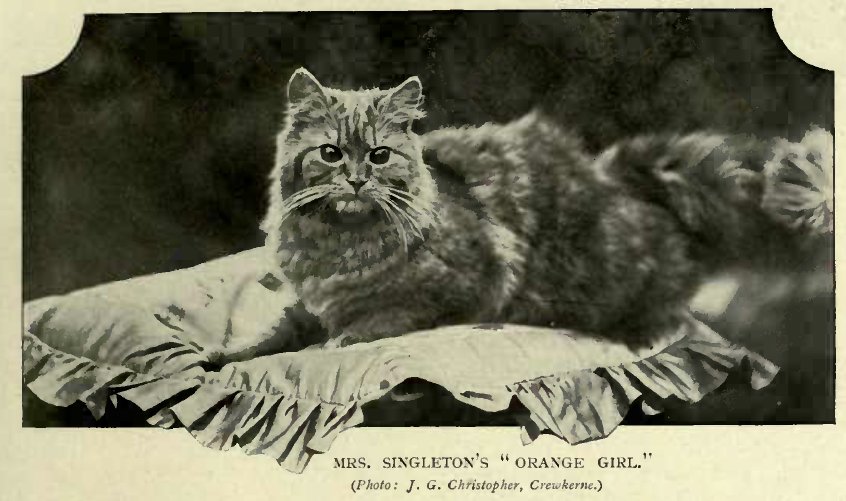
IN the short-haired varieties, these cats are sometimes called red tabbies ; but I do not think the term gives such a true idea of the correct tone of colour, which should be just that of a ripe orange when in perfection. As I write I have in my mind’s eye the mass of bright colour presented by a pile of oranges in a greengrocer’s shop, and this is the tone that is to be desired in our orange cats. There is a dash of red in the ideal orange cat, suggestive, perhaps, of the blood-oranges with which at Christmastide we are familiar. Anyhow, an orange cat should be as far removed as possible both from sandy or yellow or, as I have heard them called, lemon-coloured cats.
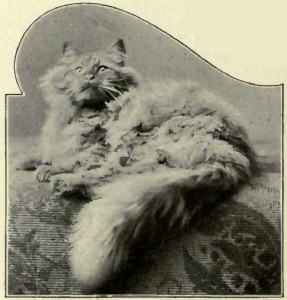
I have left out the term ” tabby ” from the heading of this chapter, and I think advisedly ; for in the Persian varieties the markings are gradually but surely vanishing, and orange cats may be said to stand in the same relation to orange tabbies as shaded silvers do to silver tabbies. I mean that most of the orange
Persians now exhibited have shaded bodies, with tabby marking on head, face, and paws. The body markings, never very strong in Persian tabbies, are even less distinct in the orange than in the silver varieties. It may therefore be said that in judging this breed as they are represented in the show pen today, colour is taken into consideration first, and tabby markings are of less account. As regards other distinctive features of this breed, I may say that it is the exception, and not the rule, to find good round heads and short noses. The longest faces I have ever seen in any felines have been those possessed by orange Persian and short-haired cats. I have really sometimes felt quite sorry for a magnificent puss of this colour whose nose was so self-assertive that every other point, however excellent, seemed to be lost sight of, and that nose with the accentuated terminus stood out with distressing prominence. Until the year 1894 the classification at the Crystal Palace was ” brown or red tabby, with or without white,” and the descriptions given in the catalogue by some owners on entering their cats read ” brown and red,” ” red-marked tabby,” ” spotted red tabby,” ” sandy Persian.” In 1895 orange and cream cats were placed together in one class.
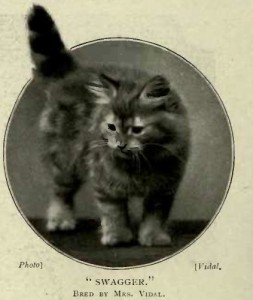
A specialist society for orange, cream, fawn, and tortoiseshell cats was founded in 1900, and although the number of members is small, yet they have proved a strong body of staunch supporters of these breeds, and a really astonishing amount of good work has been done by these few enthusiasts. The classification at the large shows has been greatly supplemented, and, whereas before the formation of the society the sexes were never separated, now this energetic little club asks for, obtains, and often guarantees extra classes. The result, therefore, to breeders of orange and cream cats is much more satisfactory, and males and females have their respective classes ; and right well have they been filled. It was in 1900 that classes for creams were introduced at shows. At the Richmond show in 1902 there were thirteen entries in male and thirteen in female orange
and c r e a m classes, the sexes, but not the colours, being divided. This was really a splendid testimony to the efforts of a specialist society of less than two years’ standing. It is such a short time ago that orange, cream, and tortoiseshell cats were relegated to the ” any other colour ” class, even at our largest shows ; now it is often remarked by reporters in the cat papers that the well-filled cream and orange classes were the chief attractions of the show.
• I will here give a copy of the circular issued by the honorary secretary inviting members !to join, and the points for orange cats, as drawn up by the specialist society, which were decided upon at the inaugural meeting :—
ORANGE, CREAM, FAWN, AND TORTOISE-SHELL SOCIETY.
LONG AND SHORT HAIRED.
As societies have been lately formed to promote the interests of one or more colours in the cat world, it has been thought by a few fanciers of orange, cream, fawn, and tortoiseshell cats that there is an opening for a society for the purpose of encouraging the breeding of these colours. The objects of such a society would be :—
(i) To secure better classification for these varieties at the different shows.
(2} To encourage fanciers to breed and show these colours by offering special prizes, etc.
(3) To improve the type of cat bred.
(4) To secure recognition for all shades of orange, cream, and fawn ; and, inasmuch as many fanciers disagree as to the merits of the different tints for eyes, to encourage the breeding and showing of specimens with green, orange, hazel, and blue eyes.
Miss Mildred Beal, Romaklkirk Rectory, Darlington, has undertaken to act as hon. sec. to the society, and will be glad to hear from any fanciers who may wish to support it.
November, 1900.
ORANGE SELF OR TABBY POINTS.
Colour and marking. —Colour to be as bright as •possible, and either self or markings to be as distinct is can be got. 25.
Coat. —To be silky, very long, •and fluffy. 25.
Size and Shape. —To be large, not coarse, but massive, with plenty of bone and substance ; short legs. 20.
Head. —To be round and broad, with short nose, ears small and well opened. 15.
Eyes. —To be large and full, and bright orange or hazel. 5.
Condition. —10.
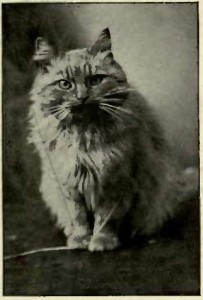
It will be noticed that the heading of these points is “orange self or tabby”; but, as I have pointed out, the cats exhibited as orange Persians are neither self-coloured nor can they be called tabby. So it remains to be seen which type of cat will in due course be the established one. I incline towards a self-coloured orange in the Persian breeds, and a very handsome cat this would be—of just one tone of bright even colour, perhaps slightly lighter on the flanks and stomach, under the tail, and with a frill of paler tone. In fact, very much the type of a smoke cat, in two shades of brilliant orange. At the same time, if real orange tabbies can be bred with the distinct body markings these should be encouraged.
At the Cat Club shows it has been customary to give the classification for orange cats marked or unmarked, so that then the judge may not have to take tabby markings into consideration, but give his awards according to colour and other points of excellence. It is the same when a class is given for sable or brown tabby, silver or shaded silver. In such classes it would be unfair to consider either the tabby markings in the one or the amount of shadings in the other. Of course, it is possible that in time orange cats may be bred to such perfection that two distinct classes will be given, namely ” orange” (selfs) and ” orange tabby.” In former years blues (selfs) and. blue tabbies were included in one class, but gradually blue tabbies have been disappearing from our midst. If, therefore, orange tabbies—I mean, of course, long-haired cats — should likewise become extinct, our browns and silvers would be the sole representatives of tabbies in the long-haired varieties.
As regards the eyes in orange Persians, the standard given in the foregoing list of the specialist society is “bright orange or hazel.” I should prefer the terms ” golden bronze or hazel,” as there is a special shade of gold with a dash of bronze or brown which seems to tone best with the bright coats of these cats. Certainly the pale yellow or greenish-yellow eye is not desirable—better a bright green eye. I often wonder if ever fanciers will be fortunate enough to breed an orange Persian with bright blue eyes, such as are seen in whites and Siamese. I have heard of a short-haired orange cat with blue eyes, and sometimes I have been told by a fancier of the Persian tribe that they had bred an orange, and its eyes had not turned from the deep kitten blue at four months, so they were fondly hoping they were going to astonish the cat world ; but their hopes were dashed to the ground, for surely and sadly a change came o’er the colour of that cat’s eyes, and it was a case of the blue that failed ! I once noticed an advertisement in one of our cat papers which announced, ” For sale, a unique orange Persian male with perfect deep blue eyes ” ; but I also remarked Orange cats make a splendid foil for other varieties. This is especially the case as regards blues and blacks; the contrast in colour enhances the beauty of each. I know that the age of this unique specimen was not one lady who, having an eye to the artistic given, and’I did not think it was worth while to write and inquire.
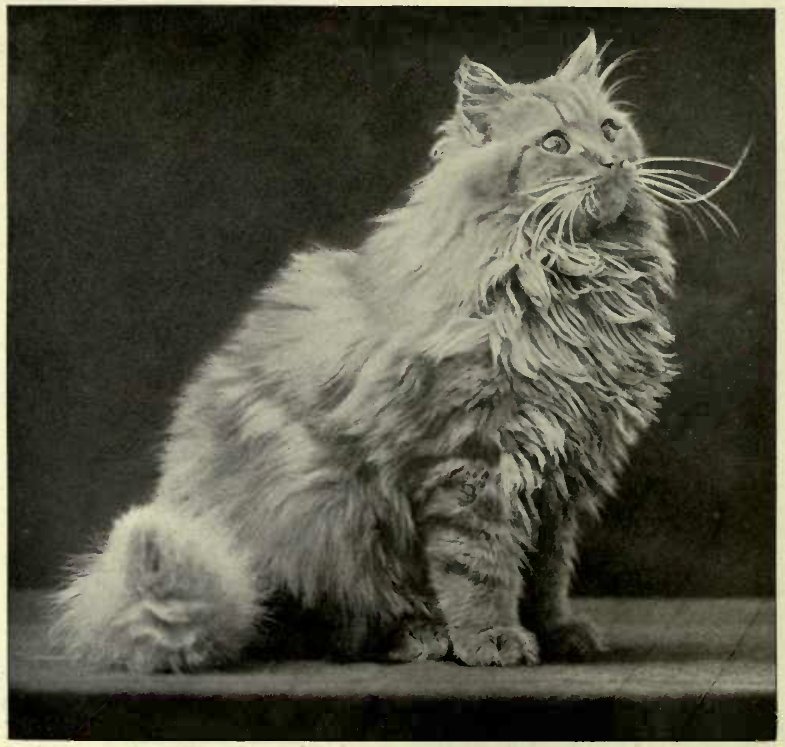
The texture of coat in this breed ought to be particularly soft and silky, and is often of great length and thickness. The kittens when born are usually dull in colour, and gradually brighten as they grow older. As is well known to cat fanciers, orange females are rarer than orange males, so their market value is higher. There is, therefore, always a flutter of excitement on the arrival of a litter, and too often fate has decreed that all are males!
keeps a blue and an orange neuter, and a lovely pair they make. I think the largest cat I ever saw was an orange neuter that simply filled the show pen with a mass of bright colour—but he had a white shirt front and white gloves ! As regards mating orange cats, they make a good cross with blacks and tortoiseshells ; and if a brown tabby lacks the admired tawny or golden tint, then an orange may assist to brighten and improve the general tone, and do away, perchance, with that drabbiness which is so undesirable in a brown tabby.
I do not think orange cats have ever been very popular, and I have remarked at shows that a certain number of people refuse to give anything but a passing contemptuous glance at the classes which contain what they call ” those yellow cats.”
A very common defect among orange Persian cats is the white or very light chin. Sometimes there is the still more damaging blemish of a white spot on the throat, spreading, perhaps, further down the chest. It is very rare to find an orange that has really a dark under-lip, and chin level in tone with the body colour. The white lip is a bugbear to breeders and exhibitors, for Nature repeats itself, and judges make notes of the defect; and in these up-to-date catty days of specialist clubs and standards of points a cat full of quality failing in one particular is too often a white elephant, if desired for anything more than a pet. I have observed that orange cats will sometimes develop a light or nearly white chin in their old age. I never consider a white spot or tuft of white hairs such a blemish to a cat if these are on the stomach, as compared with the same defect on the throat. Such a spot would not be so likely to be handed down to successive generations ; and, of course, a blemish that has to be sought for in an obscure part of the body is not such an eyesore in a self or tabby cat. I have often observed orange cats with very light hair underneath which has almost approached white ; but such defects are sometimes only temporary, whereas a white spot on the throat or a white chin remains once and for ever.
In the early days of the fancy, orange cats were decidedly more tabby marked than they are in the present day. A noted one of this type was ” Cyrus the Elamite,” born in 1889, and bred by Mrs. Kinchant, an enthusiastic fancier at that and later periods. In 1893 and 1894 Mr. Heap exhibited a handsome orange, ” Prince Charlie,” at the Crystal Palace. He also owned another, called ” Prince Lyne,” of the same breed, the celebrated tortoiseshell ” Queen Elizabeth ” being the mother of both these cats. ” Puff ” was exhibited by Mrs.
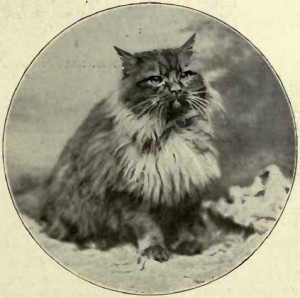
Spackman in 1894 ; this orange cat was not much marked, and ” Lifeguard ” was bred from him. It was about this date that unmarked orange Persians became more fashionable. Among females, ” Lifeguard’s ” sister, ” Goldylocks,” owned by Mrs. Marriott, was one of the very best queens ever shown. Mrs. Foote, who is still well known in the fancy, had several beautiful orange females, notably “Marigold,” “Buttercup,” and “Cowslip.” With these-cats Mrs. Foote tried to breed unmarked creams and oranges, ” Ripon,” a noted cream, being the sire. She built up several storeys of her catty castle, but then sold them to Lady Marcus Beresford. ” Trilby,” litter sister to ” Zoroaster,” a famous cream, was one of the brightest and deepest coloured orange females—or, indeed, orange cats—that has ever been seen.
Coming down to the present day, I may remark that the number of orange cats placed at stud is very limited. A great loss to the ranks of male orange Persians was ” Lifeguard,” formerly the property of Lady Marcus Beresford. This cat was almost unmarked, of a beautiful bright shade, and had an unusually round head and short face, with Ion? silky coat. He was purchased by Miss Cartmell, who is well known as an enthusiastic breeder of orange Persians, but who never exhibits. This lady has been very successful in breeding numerous fine female orange cats, and many a winner has been born to blush unseen in the Barham Cattery, near Canterbury.
Another noted winner and stud cat is “Torrington Sunnysides,” of whom a portrait is given. This cat is the property of Mrs.
Vidal, and sent out to Mr. Storey in Chicago. A son of ” Torrington Sunnysides ” has also found a home in a Chicago cattery. ” Red Knight ” was sent by the writer to Mrs. Colburn, and in an article in the American Field and Fancy mention is thus made of him :—” ‘ Red Knight,’ an orange male, with deepest orange eyes, was imported from England. He is a very good type, and has sired some beautiful kittens, notably two by Miss Adams’ ‘ Daffodil,’ G. H. Vidal, and has done a lot of winning. His colour is exceptionally good, and he has sired several prize kittens, some of which have been sent out to America and gained distinction over the water. ” Torrington Sunny-sides ” has a most luxurious house in the spacious garden surrounding Mrs. Vidal’s residence at Sydenham. The photograph is by Mr. G. W. Vidal, who dislikes taking orange cats, because the tone is so difficult to reproduce in photography, Mrs. Davies, of Caterham, has owned some good orange cats. Her male ” Hamish ” was a grand specimen, but was only twice exhibited, when he gained highest honours. He was then purchased by Mrs. very fine specimens of pure orange, with cobby bodies, wide heads, tiny ears set far apart, and beautiful coats. They have been fed on 1 Force,” and Miss Adams is going to call the male ‘ Sunny Jim.’ Another son, seven months old, of the same parentage, is the largest cat ever seen for his age, and if he continues growing will certainly be enormous.”
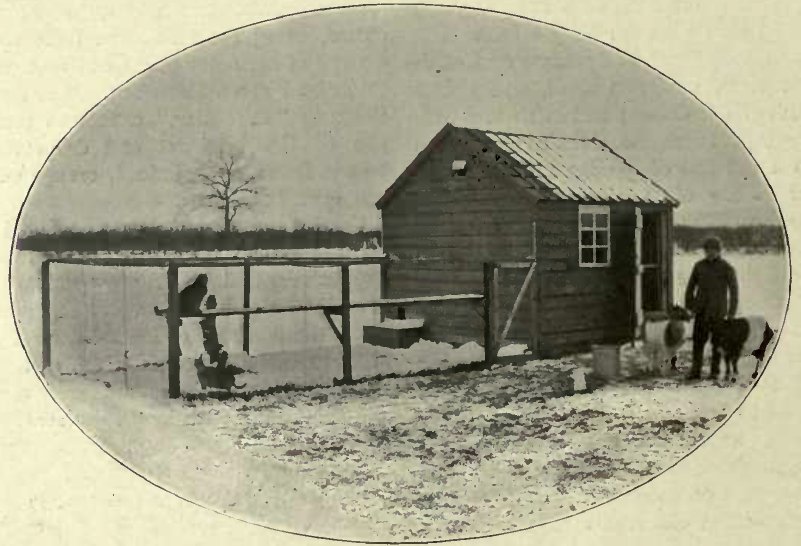
One of Mrs. Vidal’s orange kittens, ” Puck ” by name, is now owned by Mrs. Moxon, of Ilfracombe, from whom I have obtained a photograph for reproduction.
A few notes on orange Persian cats by Mrs, Vidal will be interesting to my readers :—
” It is difficult to imagine a more gorgeous colour than a really good orange lying full length in the sun. There is, however, rather a prejudice against them, chiefly because some people persist in calling them ‘ sandy ‘ or ‘ red,’ both of which names are quite misleading. I have several times had people say to me when visiting my cattery, ‘ I have always thought I did not like sandy cats, but I have never before seen a cat of such a lovely colour as the one you have just shown me.’ Six years ago,
it is very rarely seen. The absence of markings usually means absence of the rich orange colour so much admired. Any white on chin or bib is, of course, a blemish, and for breeding or show purposes such an animal is perfectly useless.
” An orange stud cat is a very useful animal to have in a cattery, for crossing with him will improve many colours, viz. tortoiseshell, brown, grey, and sable tabbies ; while if he is mated to a blue_ queen the kittens, if orange, are beautiful in colour—brighter, I think, than if two orange cats are mated together.. In when I first took up cat rearing, it was rare to see any orange cats at the shows, but now they and the creams form one of the most beautiful classes, and they have a specialist society of their own and an energetic secretary in Miss Mildred Beal.
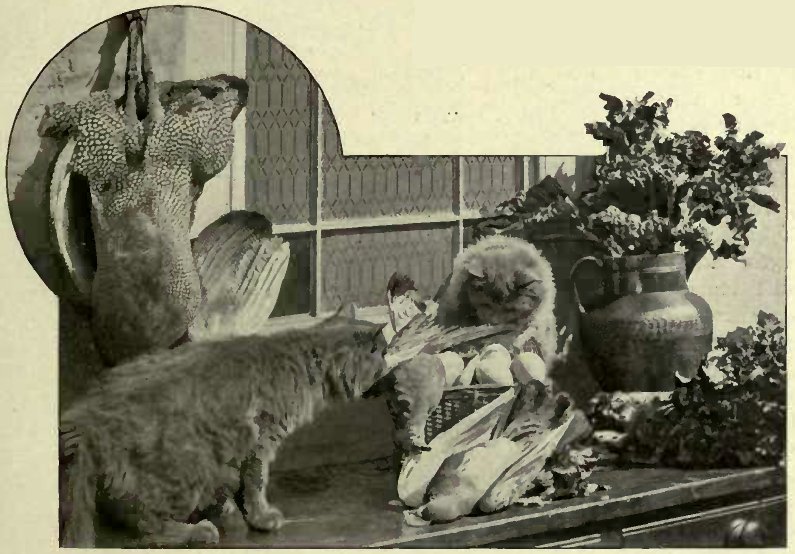
” There are two classes of oranges, one which has the ordinary tabby markings, more or less distinct, and the other which is ‘ necked ‘ all over the back in small patches, and which is usually not nearly so bright in colour as the so-called ‘ tabby ‘ markings. The correct thing is to breed a totally unmarked orange ; and, although many people claim this for their pets, 13
mating with other colours it is a toss-up what colour will predominate, but the only way to ensure all orange kittens is to mate with orange queens, when, according to my experience with my stud cat (‘ Torrington Sunny-sides ‘), the results are all orange. Mated with tortoiseshells the orange kittens are very good ; but mated with blacks the strongest colour carries the day, and the kittens are mostly black or tortoiseshell, seldom orange. Silvers, chinchillas, and smokes should, of course, never be mated with oranges, as the result would be. a horrible mixture ! Orange queens were at one time very rare, and even now are not plentiful, being delicate and difficult to rear.
“The time at which the kittens change the colour of their eyes from the baby blue to orange varies a great deal in individual animals, from seven to twelve weeks. When the eyes are very deep blue, they change to bright rich orange or hazel; but if of a pale blue, they change very quickly to a poor yellow, and never get the rich dark orange which the deeper blue get. Therefore rejoice when you see your kittens with deep blue eyes. Some of our kittens have had the most lovely deep blue eyes, and great has been our sorrow as we found the inevitable change coming on. If I could only manage to get some kittens with the permanent blue eyes that the best white cats have, I should indeed be proud ; but thinking of the kittens with terrible white chins and under-coats, which would crop up in every litter and would have to be drowned, quite deters me from sending my orange queens to white studs with blue eyes ! All who have been accustomed to frequent the show pens will remember Miss M. Beal’s splendid old orange queen ‘ Jael,’ who up to the last, although nearly fourteen years old, always took first prize, and was a very good specimen of what an orange queen should be-—of a bright rich orange, without any suspicion of light under her chin or chest (the usual weak point), and having the splendid head, short nose, and good cobby shape which all breeders strive for. Short-haired orange cats are often seen about our towns and villages, and are always called ‘sandy,’ but are not, I think, held in much account. They are distinct from, the so – called ‘ red tabby,’ which is a recognised colour in our shows.”
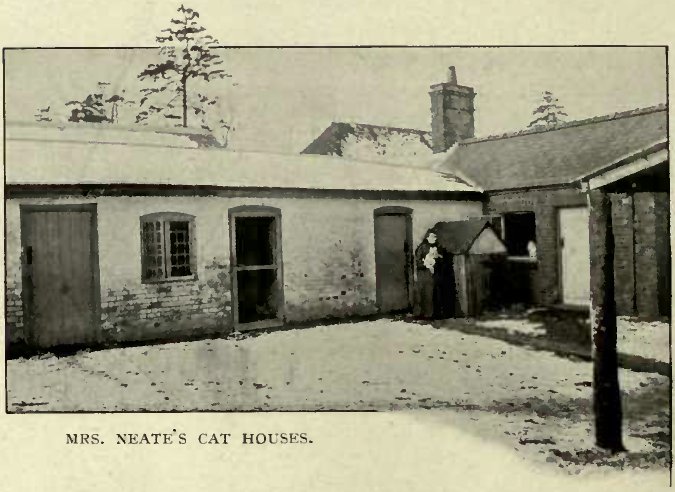
Among the prize – winning females of the present day I must not forget to notice Mrs. Singleton’s “Orange Girl,” bred from Miss Beal’s noted strain. This cat has had many honours showered upon her during a very short career, and as there must always be a scarcity of queens in this breed, this fine specimen is a valuable possession.
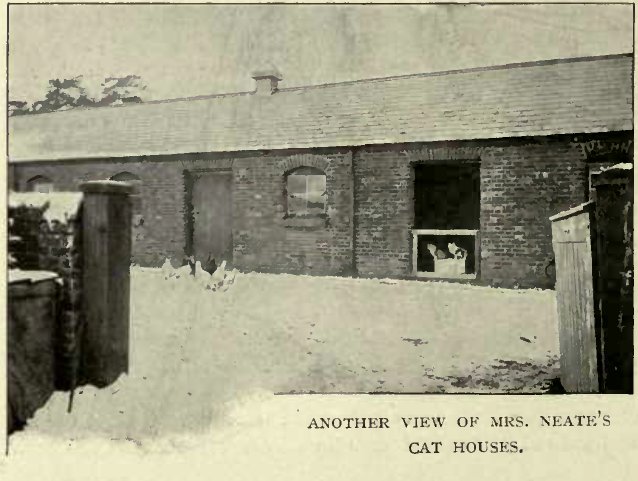
So long as there are two cat clubs and two registers there will be a confused multiplicity of names, and so yet another orange male called ” Puck ” inhabits the cat world. This handsome fellow is owned by the Hon. Mrs. McLaren Morrison, to whom I had the pleasure of awarding first prize and many specials at the Botanic show held in June, 1902. His vivid colouring and well-shaped limbs and splendid eyes will always make him a conspicuous specimen in the show pen. Alas ! his photograph does him but scant justice. Quite a surprise packet appeared at the Crystal Palace show of 1902 by the appearance of a very handsome young male in ” William of Orange ” exhibited by Mrs. Stillwell, and bred from Dr. Roper’s noted black ” Johnnie Fawe ” and tortoiseshell queen ” Dainty Diana.” This cat was awarded first and many specials, and was claimed by Lord Decies at catalogue price. As ” William ” was not a year old when he won his laurels, it may readily be believed that he has a distinguished career before him, and may add another to the long list of winners owned and exhibited by Lady Decies. No orange male cat is better known in the fancy than that splendid fellow ” The King’s Own,” belonging to Mrs. Neate. He has had a most successful career, and may be considered as nearly self-coloured an orange as any yet exhibited.
Mrs. Neate is a devoted admirer of this breed and also a great cat lover, and has recently started an arrangement for boarding cats, and truly I know of no place better adapted for successful cat keeping than the home of Mrs. Francis Neate, at Wernham, near Marlborough ; situated as it is in the very heart of the country, a mile from any other house, her cats can enjoy their liberty with perfect safety.
A large range of brick-built and slated outhouses has been converted into catteries and comfortably fitted. All have wooden floors, wire doors, and large runs attached. A number of portable houses and runs are dotted about the kitchen garden and meadows. An empty cottage serves as an isolation hospital, or place of quarantine for cats returning from shows.
A herd of pure-bred goats supply the inmates of the cattery with milk, and rabbits, which abound, form their staple food when in season. The largest of the outhouses is fitted with a Tortoise stove, carefulty guarded. The pride of Mrs. Neate’s cattery is, of course, the famous orange stud “The King’s Own.” He is the sire of the two winning orange queens ” Mehitabel of the Durhams ” and ” Glory of Prittlewell.”
Fitting mates for him are ” Wernham Titmouse “^(tortoiseshell-and-white), ” Evening Primrose” (a cream daughter of ” Champion Midshipmite ” and ” Hazeline “), also ” Mimosa ” (an orange bred by Miss Cartmell from ” Richmond Bough ” and ” Mistletoe “) ; these occupy the house adjoining the stables.
” Champion Bundle ” and ” Betsy Jane,” a lovely little blue with glorious orange eyes, are the only blues of the establishment. Latterly Mrs. Neate has reduced her own stock of breeding queens, and makes a speciality of receiving cats during the holidays. Judging by the number of cat fanciers who sent their pets to Mrs. Neate during the summer of 1902, it is certain that a great want has been most efficiently supplied. Not only does Mrs. Neate give personal supervision to her catty boarders and visitors, but they have splendid caretakers on the premises. These custodians are Mrs. Neate’s big St. Bernard and a chow-chow, who jealously guard the Wernham cattery. These dogs are on the very best terms with the feline inmates, and the strange pussies very soon appear to settle down to an amicable cat-and-dog life. The accompanying photographs, as will be seen, were taken in the depth of winter. These brick-built houses, slate roofed and with wooden floor, are splendidly adapted for keeping the cats snug and warm during the cold weather. One of the buildings illustrated is 25 feet by 15 feet, and has three windows. This house is provided with large table, shelves, and chairs, and cosy sleeping-boxes. An outside wire run, of the same length and width as the building, is erected for an exercise ground in summer weather.
Mrs. Neate has kindly supplied me with a few notes on orange Persian cats :— ” It was in 1897, at Boscombe show, that I claimed the winner in a class of twenty-six kittens, my now well-known orange Persian stud ‘ The King’s Own.’ The same year, at the Crystal Palace, I purchased a lovely orange female kitten sired by Mrs. Pettit’s ‘ Champion King of Pearls ‘ and the tortoiseshell-and-white ‘ Dainty Doris.’ From her I fondly hoped to establish a breed of blue-eyed oranges, which feature would be charming in the variety ; but alas ! she came home to sicken and die, as so many another valuable kitten has done, and I have never since been able to obtain an orange of either sex sired by a blue-eyed white.
” It is most difficult to breed oranges without white lips and chins ; the pink nose, too, is a feature in the breed that I do not like.
” I have found crossing an orange male with a cream female the surest way to breed sound-coloured specimens of both sexes and varieties, e.g. ‘ Mehitabel of the Durhams ‘ (a really rich-coloured unmarked orange queen, and quite free from the objectionable light shading on lips and chin) ; she was bred by Mrs. D’Arcy Hildyard from her cream female ‘ Josephine of the Durhams’ and ‘The King’s Own.’ Again, from a blue male and a tortoiseshell queen you are more certain of breeding good oranges (though seldom of the female sex) than from mating tortoiseshell and orange together ; in the latter case more often than not black kittens predominate in the litter, and there is rarely, if ever, an orange female amongst them.
” Mrs. Vidal’s famous orange stud ‘ Torring-ton Sunnysides ‘ was a son of my light blue ‘ Champion Bundle ‘ and a tortoiseshell dam ‘ Torrington Owlet,’ herself of an orange strain. Mrs. Walford Gosnall’s ‘ Rufus ‘ (whose name discloses his colour) was also the result of this union. ‘ Red Ensign,’ the orange kitten who won first and three specials at Westminster in 1902, was bred by me from ‘ Champion Bundle ‘ and ‘ Mimosa,’ an orange queen of cream breeding, and with his litter brother ‘ Scarlet Lancer ‘ took first and silver medal for the best pair of kittens. The latter is now the property of Miss Cartmell, and has grown into a fine cat. Unfortunately for the cat fancy generally, ‘ Red Ensign ‘ was claimed at the show, and is now a house pet.
” The best orange kittens I have bred were from my ‘ Wernham Titmouse,’ a tortoiseshell-and-white who owns an orange dam, and ‘ The King’s Own ‘ ; the whole litter were females, and redder than any oranges I have seen. These never lived to see a show, and their death was one of the greatest disappointments I have experienced in my career. The demand for good orange and cream females is greater than the supply ; in fact, these colours are decidedly ‘ booming,’ and better classification is given for them at our principal shows.
” At the Crystal Palace show of 1898 there were only four entries in the open class for orange and cream males, and four of the same varieties in the female class, compared to the ten entries in orange and cream male classes and the same number in the female classes at the Cat Club’s show, held at Westminster, 1902. These facts speak for themselves of the increased interest now taken in these varieties.
” Unlike some of the warmer tinted of us humans, orange cats of both sexes are particularly sweet tempered, showing great attachment to their owners. They are of strong constitution and attain to great size, being at present free from the in-breeding that is practised amongst many other varieties of our show cats. A small piece of sulphate of iron in the drinking water will enrich the colour of orange and tortoiseshells, besides being an excellent tonic, especially during the moulting season.
” Orange Persian cats do not, as a rule, make good photographs, as they lack expression compared to the short-haired tabby varieties of this colour.”
The Misses Beal, of Romaldkirk, near Darlington, have long been associated with orange and cream cats. ” Jael ” was quite unique as an orange female, and at fifteen years of age could yet win in her class by reason of her grand colour, perfectly shaped head, short face, and tiny, well-set ears. Such a cat stands out in any breed, and such a cat may never again be bred. ” Jael ” died in 1902, after a long and successful career.
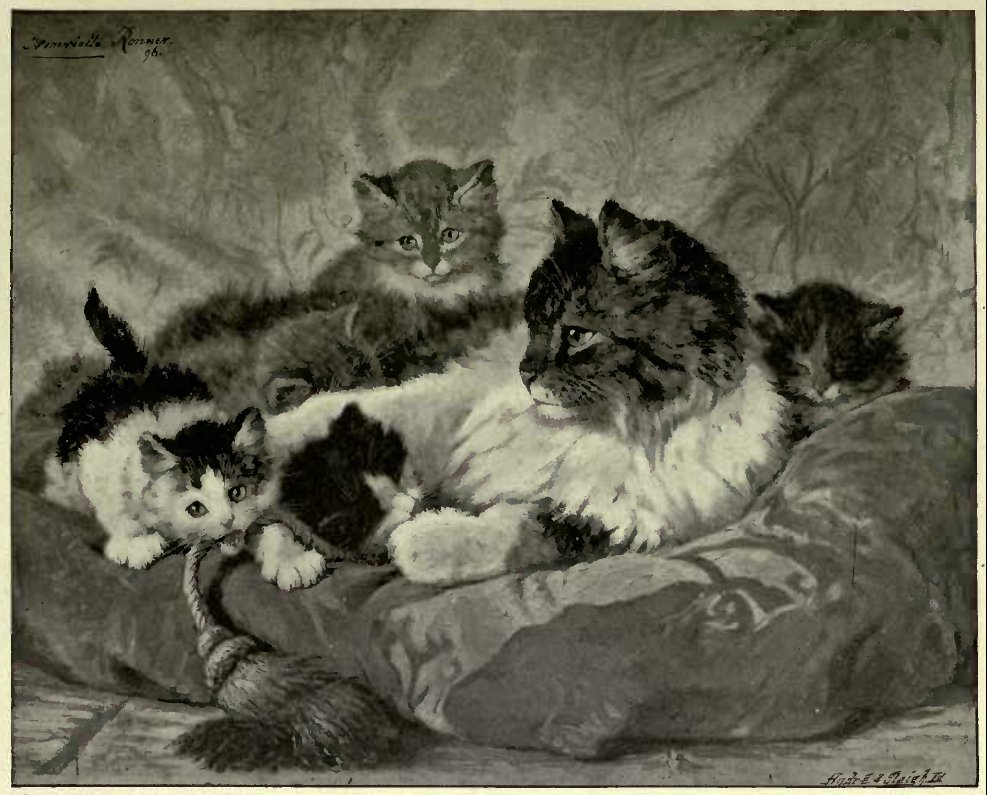
Miss Beal’s male orange ” Minotaur ” is one of the most beautiful cats of this breed now exhibited, and has quite the best round head and face, with sweetest expression. These are qualities too often lacking in orange cats.
Miss Beal’s name is, perhaps, more closely associated in the cat world with cream cats, and in my next chapter on this breed she has kindly supplied some notes.
Another fancier of both orange and cream cats is Mrs. D’Arcy-Hildyard, and to her I am indebted for the following notes on orange Persian cats :—
” Until comparatively lately I confined myself entirely to the breeding of creams, and my efforts were attended with considerable success, both in multiplying the number of cats of that colour—I bred thirteen one year—and in filling the classes given for cream females. I was particularly lucky in breeding many creams of the gentler sex.
” The birth of the Orange and Tortoiseshell Society fired me with ambition to start breeding oranges. I was much fascinated with the colour, though I hate their being penned beside the creams at shows, as they completely take all colour out of the lighter animals and give them a washed-out appearance. I started by crossing my cream queen ‘Josephine of the Dur-hams ‘ with Mrs. Neate’s famous ‘ The King’s Own.’ This proved a most satisfactory cross, the results being three rich-coloured unmarked orange kittens, one male and two females. I sold one female to Miss Scratton, of Prittlewell Priory, and it has, I hear, grown into a very handsome cat ; the other two I kept, and they won all before them at Manchester Kitten Show, 1901, and were shown at Slough after, where the male was claimed. The remaining one, ‘ Mehitabel of the Durhams,’ I kept, and she won me many prizes last winter, and being mated this year to ‘ Champion Romaldkirk Admiral’ has presented me witli a litter of two creams and an orange. Certainly creams and oranges cross well, and often I think produce a brighter and deeper tone of colour than is obtained from other shades. I have lately purchased an orange torn, and by cross-
ing him with ‘ Hazeline,’ one of my cream queens, have got a splendid litter of seven pure oranges. This, I think, proves that the cream and orange cross is good, and that they breed very true. Oranges bred by crossing other colours seem to me rather spasmodic, if I may use the term. When breeders try crossing an orange and a tortoiseshell they very often get blacks and blues as well as oranges ; on the other hand, from a blue and a tortoiseshell cross sometimes an orange is obtained. But they do not seem able to count exactly on the results.
” Reliability is what I claim from the cream and orange cross. I emphatically believe in mating creams to creams if you wish to get a good pale colour and few markings, and oranges and creams crossed have certainly produced good specimens of both colours for me. I speak from my own experience.
” I hope to do great things by trying a cross between my orange torn ‘ Benjamin’ and ‘ Mehitabel.’ Miss Winifred Beal’s ‘ Minotaur ‘ was the result of a cross between a cream and a tortoiseshell. Her well-known ‘ Garnet’ is the daughter of a cream and a blue. At present there is, to my mind, no orange female on the show bench to compare with the late ‘ Jael,’ owned by Miss Mildred Beal, whose brilliant colour and perfect head with its tiny ears made her hold her own at all the shows up to within two months of her death at quite a venerable age ; but I hope in the future, as oranges become more popular and breeders work hard at producing good specimens, we may see her like again. I was . much taken at Richmond show with Mrs. Singleton’s ‘Orange Girl,’ and also with the kitten of that colour exhibited by the same lady at Manchester. Every year, I think, shows that the general world is becoming more alive to the beauties of orange and cream cats, as proved both by the large increase in entries of these colours at the principal shows and the great demand for kittens when any are offered for sale. Undoubtedly breeders owning creams should stick to them, if they wLh to produce good oranges—see the many splendid specimens sired by ‘ Midshipmite ‘ and ‘ Admiral.’
” It is a hard matter to say decisively what tint orange kittens should be when born, i have known them enter the world a bad cream, and gradually grow redder till they develop into the brilliant colour we all look to see in a cat of orange hue. Personally, I prefer them born a dark shade ; they usually lighten and brighten a little, but on the whole I think that is the more satisfactory of the two. It is distinctly discouraging to see a washed-out
” I think the time is approaching when the orange and cream cats are going to be among the most attractive classes at our bigger shows. Already the classes are much better filled than when I first joined the fancy, and you always find an admiring crowd in front of their pens. I wish, though, that a nice sprinkling of blues could always be placed between the two colours at shows. The close company of the oranges is so excessively unbecoming to the looking kitten when you are expecting a bright orange one.
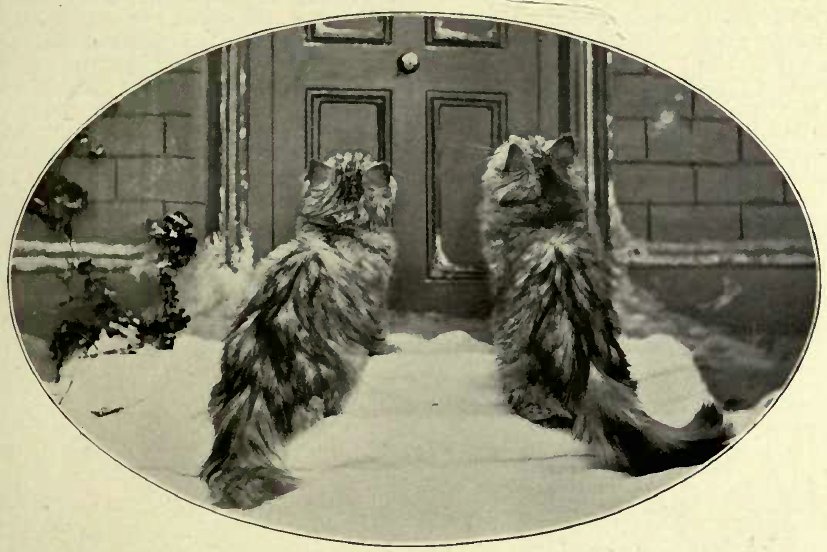
” Fanciers differ about the eyes which are supposed to be correct in this breed. Hazel eyes are universally acknowledged to be the right thing. Personally, I admire green, or rather eau-de-nil eyes, as giving more contrast to the colour of the coat, but you do not often see them. I have always wished to breed a cream with blue eyes—I do not mean the baby blue, but the colour -that Siamese have—and only the other day I sold a kitten three months old with brilliant blue eyes of this tint, and shall be anxious to know whether they change in time or not.
creams, while when you see the three colours together they are especially lovely. To see cream and orange cats at their best they should be at large in the country and running about on the green grass.”
In 1902 an Orange and Cream Cat Club was started by a few enthusiastic breeders of these varieties over in America. The Misses Beal, Mrs. Vidal, and Miss Frances Simpson were elected as honorary members. The following is an extract from Field and Fancy, the American weekly paper :—
ORANGE CATS.
There is very little doubt that this is a colour that has from the beginning of the fancy in America been very popular, and has had a very strong hold upon the American love for colour. But, of course, as is generally the case with the popular ones, the supply has never been too plentiful, and probably never will be as regards the queens, for they only appear once in a while, according to what seems to be one of Nature’s rules, that the queens should be tortoise-shells.
The Orange and Cream Club is probably destined to do a great deal for the variety, which is one of the colours from which it takes its name. Breeding orange cats opens quite a field, for in attaining your end you can at the same time indulge in other colours, for undoubtedly a cross with a tortoiseshell will be found necessary to keep the colour sufficiently intense, and at other times it may be quite as well to throw in a little black. The tendency for the queens to be tortoiseshells may possibly be somewhat overcome in time, but these inherent traits in colours in animals and birds are often so strong that they have a knack of reappearing even after several generations. We occasionally see queens of the orange colour, and these are usually high quality ones, both in colour and type ; but the orange queens are not destined to at present make heavy classes by themselves. Though the standard calls for orange eyes, it is a curious coincidence that the most consistently successful cat of recent times has been Miss Beal’s ” Jael,” who had green eyes ; but so good was her colour, so good her type, that she generally won when exhibited.
The struggle carried on in the British Isles for some years to breed these cats without marks has been hardly a success, and there have not been very many evolved of that colour that were really without marks, and it is a great question if in this craze for absence of marks they have not been passing by a lot of good cats. As far as we personally are concerned in the matter, we see little to be gained by the absence of marks in the orange cats. If the colour had been very prolific in numbers it might have been a good idea to try and split up the classes, but they were never too well filled, and there is room still for plenty more, though we cannot complain so much at th& representation that they have had in America last season, either in numbers or quality.
